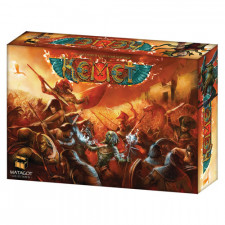Kemet Review
on Feb 10, 2016

Jason: 
RC: Few games in recent history have blended the traditional labels of Euro and Ameritrash as well as Kemet. While many games combine a distinct mechanic from one camp with a distinct mechanic from the other, few games truly merge the two into something great. Kemet is one of those games. The combat is vicious and direct without relying on random dice rolls while the economy and action selection force you to deny your opponent the spaces and powers they were angling for.
JM: Indeed it has been hailed as an exemplary so-called “Weuro,†though to be honest, I’ve always thought it leaned more towards a Euro with a nasty streak rather than a tamed Ameritrash. Its outstanding and garish components tend to earn its latter label more so than any distinctive game play or theme associated with that style of gaming. Ironically, where I think this mostly-Euro succeeds better than even many pure American style designs is in forcing player interaction. By opening the board to innovative ways of moving armies, you can’t hide in a corner nor easily defend choke-points, because practically speaking there are neither. And by awarding points for victorious attacks and capturing temples, you can’t win turtling.
RC: I couldn’t agree more. Kemet is bereft of extraneous mechanics or frustrating edge cases that can bog down many thematic games. The core mechanics are simple and easy to grasp which means that within minutes you are going to look around the table and realize that Kemet is a game that drives home the idea that some of the best gaming experiences come when you stop playing the rules and start playing the people. With limited opportunities to earn permanent victory points, you’ll have to start scheming and plotting around tenuous alliances while waiting for the perfect moment to snatch temporary points out of your opponent’s hands. Few things in gaming feel better than convincing your opponents that they need to stop the “leader†only to execute a perfect round of upgrades and combat that propels you to victory.
JM: That creates beautifully tense competition from the gate (or should I say stargate?) which the design’s myriad limitations compound tenfold. With its non-standard movement the board actually feels claustrophobic, an enemy waiting beyond every border. The five actions per phase ceiling, like any design employing the mechanic well, ensures that you can’t do everything you’d like. Access to power tiles is wholly dependent on your pyramids’ levels, not to mention economy. With a finite troop reserve and identical battle card decks, fights are invariably close and near-run entanglements. Even half your victory points are fleetingly at risk to be stolen from you every round! Some gamers, especially grognards, might decry these as bothersome restrictions. But those types can stick to their hex-and-counters and traditional dudes-on-a-map. Kemet is certainly a war game, but like few others in the category.
RC: That claustrophobia, coupled with attacking being one of the few ways to earn a permanent victory point, combine to keep players on their toes. While gaining access to the top tier powers takes some time, there is none of the boring slow burn that often accompanies games with tech trees or powers. If you hang back, scared to attack until you’ve summoned a powerful giant scorpion or evil mummy, you’ll find yourself too far behind. Not even the game’s excellent turn order mechanic can save you then. Kemet is a game where turn order is critical to your strategy, and the player with the fewest points gets the powerful benefit of determining when everyone acts. Since timing is so critical, that is often a benefit worth deliberately pursuing if you can use it to leverage a late attack or snagging a coveted power ahead of your opponents. Just don’t fall too far behind. Victory point totals can swing dramatically, but it’s important to stockpile permanent VPs throughout the game.
JM: Yet even though turn order is certainly important, I find it’s not as game-determining as some detractors have leveled. That’s because of the dynamic action selection. With its alternating turns, players can respond to various moves betrayed by the “I-go, then Everyone-Else-Goes†format. You’re simply not able to implement grand sweeping strategies in one stroke, but must execute plans one bit at a time as everything partly unfolds before all. Thanks to the unique teleportation aspect and divine intervention cards, you can still pull off surprises. However, other elements like mathematical battles and the adjacency rule before city assaults often telegraph your plans and may be countered. Again, some may feel shackled by such a limitation. But the evolving scenario builds great tension and angst. Furthermore it kills one of the genre’s most frustrating banes: downtime.
RC: Between the ever mounting tension and the political maneuvering necessary to distract your opponents, you’ll never feel like you aren’t wholly engaged in the action that’s going on. If you aren’t paying attention to everyone’s game state and cajoling your opponents, you’re missing a huge part of the strategy. And while I agree that games where the last player to act simply scoops a few points to win may leave a dry sandy taste in your mouth, it generally means they executed their strategy just a little bit better than yours. Being the last to act in a round never happens by accident and the feeling you get when you take advantage of that position to surge into victory is as exciting for you as it is heartbreaking for your enemies. That ability to surge is also great because it means that rarely are you completely out of the game. Two successful attacks on an opponent’s temple represent half or almost half of the points needed to win. You’re never out of the running and everybody else is always within striking distance. It’s excellent, and adds to the tension and energy.
JM: Yeah, to my mind, more problematic than player order are the power tiles, although their selection is highly influenced by turn order. Not because they’re not awesome. They are and bring a ton of variety, strategy and replayability. Finding those killer combos is both fun and satisfying. But, man, they are intimidating for the uninitiated. Spread about the table like a banquet for Bacchus - or his Egyptian equivalent - they can be truly overwhelming. If you’re not familiar with the game, or even play it very often, it creates a disproportionate amount of time between resolving that action and any of the others because of the frequent referencing required. And for a design whose action selection element prevents downtime, it can cause a bit of drag. Furthermore, the title is generally smooth and accessible, if not for those tiles posing a significant learning curve. Not just in discerning what they do and deciphering their hieroglyphics, but discovering how best certain combinations work together.
RC: I appreciate that many of the tiles synergize across colors. It isn’t enough to focus solely on any one color. Often the best plans involve a two pronged approach at minimum. If you need that third color, you can always storm your opponents walls and temporarily use their pyramids to your advantage as well! I also like those hieroglyphics; they create a consistent symbology that allows the game to be language independent once you’ve learned them. Of course, learning them takes a while as you pointed out. Between all those powers and calculations necessary to plot out a round, the game can also suffer from a bit of the dreaded analysis paralysis. There are a number of ways to claim victory that will typically leave you exposed in one way or another and working your way through your options may leave other players twiddling their thumbs. Not you however; plotting and working your way through Kemet’s fantastic decision tree contributes to the excitement and tension of the game. The only thing that feels better than executing a perfect plan is scrambling to salvage one that gets interrupted halfway through and still coming out on top.
JM: I enjoy that back-and-forth tension and open-ended strategy. Paired with the numerous options and give-and-take you allude to, the victor’s triumph is usually by razor thin margin. That’s not to say every player will be so close, but the score is generally tight among the leaders. Kemet really succeeds in creating a fresh experience, but it also requires a different mindset coming into. Again, it’s lavish production value and components belie what I think is its true soul: a nasty Euro. The dudes on its map scream out traditional war game to the uninformed. But with its unconventional movement, mathematical combat resolution, abstract production and arbitrary action selection, it plays nothing like one. Indeed it’s more of a metamorphosed war game whose thematic anchors are surprisingly aweigh. With that perspective Kemet is a grandly unique design.
RC: Indeed. If there is something mechanically similar, I haven’t played it. The surging movement and combat give it a unique tempo and require you to time your strikes with surgical precision. You’re on your toes from the get go and know that it is up to you to win or lose with tactics and strategy. There is no cursing of the dice or complaints about the fates at the end of Kemet; there is just a smile and acknowledgement to your opponent that they have bested you, and a request for a rematch. Kemet’s mechanics are familiar yet it stands apart from, and above, the many games it might be compared to.

 Customer Support
Customer Support  Subscribe
Subscribe 




 Account
Account  Wishlist
Wishlist 

